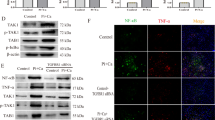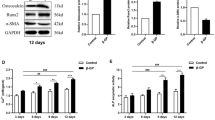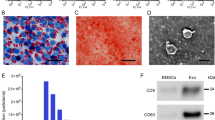Abstract
Vascular calcification (VC) is highly prevalent and represents a major cardiovascular risk factor in chronic kidney disease (CKD) patients. High phosphate (HP) levels are strongly associated with VC in this population. Secreted frizzled-related protein 5 (SFRP5), one of the inhibitors of the Wnt pathway, is a known anti-inflammatory adipokine with a positive effect on metabolic and cardiovascular diseases, in addition to its anticancer potency. However, the role of SFRP5 in the pathophysiology of VC is unclear. This work aimed to study the mechanism of action of SFRP5 on the progression of HP-induced VC, which resembles the CKD-related VC, through its direct effect on vascular smooth muscle cells (VSMCs) in vitro. Addition of SFRP5 significantly inhibited HP-induced calcification of VSMCs as determined by Alizarin red staining and calcium content. The inhibitory effect of SFRP5 on calcification of VSMCs was due to the suppression of HP-induced expression of calcification and osteoblastic markers. In addition, SFRP5 abrogated HP-induced activation of the Wnt/ß-catenin pathway, which plays a key role in the pathogenesis of VC. The specificity of SFRP5 for the inhibition of calcification of VSMCs was confirmed by using a neutralizing antibody to SFRP5. Our results suggest that SFRP5 inhibits HP-induced calcification of VSMCs by inhibiting the expression of calcification and osteoblastic markers, as well as the Wnt/ß-catenin pathway. Our study may indicate that SFRP5 is a potential therapeutic agent in calcification of VSMCs.




Similar content being viewed by others
References
Eknoyan G, Lameire N, Barsoum R et al (2004) The burden of kidney disease: improving global outcomes. Kidney Int 66:1310–1314
Briet M, Burns KD (2012) Chronic kidney disease and vascular remodelling: molecular mechanisms and clinical implications. ClinSci 123:399–416
Liabeuf S, Desjardins L, Diouf M et al (2015) The addition of vascular calcification scores to traditional risk factors improves cardiovascular risk assessment in patients with chronic kidney disease. PLoS ONE 10:e0131707
Covic A, Kanbay M, Voroneanu L et al (2010) Vascular calcification in chronic kidney disease. ClinSci 119:111–121
Moe SM, Chen NX (2008) Mechanisms of vascular calcification in chronic kidney disease. J Am Soc Nephrol 19:213–216
Palit S, Kendrick J (2014) Vascular calcification in chronic kidney disease: role of disordered mineral metabolism. Curr Pharm Des 20:5829–5833
Palmer SC, Hayen A, Macaskill P et al (2011) Serum levels of phosphorus, parathyroid hormone, and calcium and risks of death and cardiovascular disease in individuals with chronic kidney disease: a systematic review and meta-analysis. JAMA 305:1119–1127
El-Abbadi MM, Pai AS et al (2009) Phosphate feeding induces arterial medial calcification in uremic mice: role of serum phosphorus, fibroblast growth factor-23, and osteopontin. Kidney Int 75:1297–1307
Yao L, Sun YT, Sun W et al (2015) High phosphorus level leads to aortic calcification via β-catenin in chronic kidney disease. Am J Nephrol 41:28–36
Shao JS, Aly ZA, Lai CF et al (2007) Vascular Bmp Msx2 Wnt signaling and oxidative stress in arterial calcification. Ann N Y Acad Sci 1117:40–50
Gough NR (2012) Focus issue: Wnt and β-catenin signaling in development and disease. Sci Signal 5:eg2
Johnson ML, Kamel MA (2007) The Wnt signaling pathway and bone metabolism. Curr Opin Rheumatol 19:213–216
Martínez-Moreno JM, Muñoz-Castañeda JR, Herencia C et al (2012) In vascular smooth muscle cells paricalcitol prevents phosphate-induced Wnt/β-catenin activation. Am J Physiol Renal Physiol 303:F1136–F1144
Montes de Oca A, Guerrero F, Martinez-Moreno JM (2014) Magnesium inhibits Wnt/β-catenin activity and reverses the osteogenice transformation of vascular smooth muscle cells. PLoS ONE 9(2):e89525
Ouchi N, Higuchi A, Ohashi K et al (2010) Sfrp5 is an anti-inflammatory adipokine thatmodulates metabolicdysfunction in obesity. Science 329:454–457
Li Y, Rankin SA, Sinner D et al (2008) Sfrp5 coordinates foregut specification and morphogenesis by antagonizing both canonical and noncanonical Wnt11 signaling. Genes Dev 22:3050–3063
Wang R, Hong J, Lin R et al (2014) SFRP5 acts as a mature adipocyte marker but not as a regulator in adipogenesis. J Mol Endocrinol 53:405–415
Jaikanth C, Gurumurthy P, Indhumathi T et al (2014) Emergence of sfrp5 as a pleiotropic adipocytokine and its association with wnt signaling. Minerva Endocrinol July 8[Epub ahead of print]
Román-García P, Carrillo-López N, Fernández-Martín JL et al (2010) High phosphorus diet induces vascular calcification, a related decrease in bone mass and changes in the aortic gene expression. Bone 46:121–128
Miyoshi T, Doi M, Usui S et al (2014) Low serum level of secreted frizzled-related protein 5, an anti-inflammatory adipokine, is associated with coronary artery disease. Atherosclerosis 233:454–459
Jin X, Guo B, Yan J et al (2015) Angiotensin IIincreases secreted frizzled-related protein 5(sFRP5) expression through AT1 receptor/Rho/Rock1/JNK signaling in cardiomyocytes. Mol Cell Biochem 408:215–222
Giachelli CM (2009) The emerging role of phosphate in vascular calcification. Kidney Int 75:890–897
Rong S, Zhao X, Jin X et al (2014) Vascular calcification in chronic kidney disease is induced by bone morphogenetic protein-2 via a mechanism involving the Wnt/β-catenin pathway. Cell Physiol Biochem 34:2049–2060
Li X, Yang HY, Giachelli CM (2008) BMP-2 promotes phosphate uptake, phenotypicmodulation, and calcification of human vascular smooth muscle cells. Atherosclerosis 199:271–277
Herencia C, Rodríguez-Ortiz ME, Muñoz-Castañeda JR et al (2015) Angiotensin II prevents calcification in vascular smooth muscle cells by enhancing magnesium influx. Eur J Clin Invest 45:1129–1144
Lee KM, Kang HA, Park M et al (2012) Interleukin-24 attenuates β-glycerophosphate-induced calcification of vascular smooth muscle cells by inhibiting apoptosis, the expression of calcification and osteoblastic markers, and the Wnt/β-catenin pathway. Biochem Biophys Res Commun 428:50–55
Chatani N, Kamada Y, Kizu T et al (2015) Secreted frizzled-related protein 5 (Sfrp5) decreases hepatic stellate cell activation and liver fibrosis. Liver Int 35:2017–2026
Carstensen M, Wiza C, Röhrig K et al (2014) Effect of Sfrp5 on cytokine release and insulin action in primary human adipocytes and skeletal muscle cells. PLoS ONE 9:e85906
Mikhaylova L, Malmquist J, Nurminskaya M et al (2007) Regulation of in vitro vascular calcification by BMP4, VEGF and Wnt3a. Calcif Tissue Int 81:372–381
Mori H, Prestwich TC, Reid MA et al (2012) Secreted frizzled-related protein 5 suppresses adipocyte mitochondrial metabolism through WNT inhibition. J Clin Invest 122:2405–2416
Bovolenta P, Esteve P, Ruiz JM et al (2008) Beyond Wnt inhibition: new functions of secretedFrizzled-related proteins in development and disease. J Cell Sci 121:737–746
Stuckenholz C, Lu L, Thakur PC et al (2013) Sfrp5 modulates both Wnt and BMP signaling andregulates gastrointestinal organogensis in the Zebrafish, Daniorerio. PLoS One 8:e62470
Acknowledgments
This study received financial support from Beijing Municipal Science and Technology Commission Funds (D131100004713001) and National Natural Science Foundation of China (81300607).
Author information
Authors and Affiliations
Corresponding author
Ethics declarations
Conflict of Interest
The authors declare that they have no conflict of interest.
Human and Animal Rights and Informed Consent
This article does not contain any studies with human or animal subjects performed by any of the authors.
Rights and permissions
About this article
Cite this article
Deng, D., Diao, Z., Han, X. et al. Secreted Frizzled-Related Protein 5 Attenuates High Phosphate-Induced Calcification in Vascular Smooth Muscle Cells by Inhibiting the Wnt/ß-Catenin Pathway. Calcif Tissue Int 99, 66–75 (2016). https://doi.org/10.1007/s00223-016-0117-7
Received:
Accepted:
Published:
Issue Date:
DOI: https://doi.org/10.1007/s00223-016-0117-7




